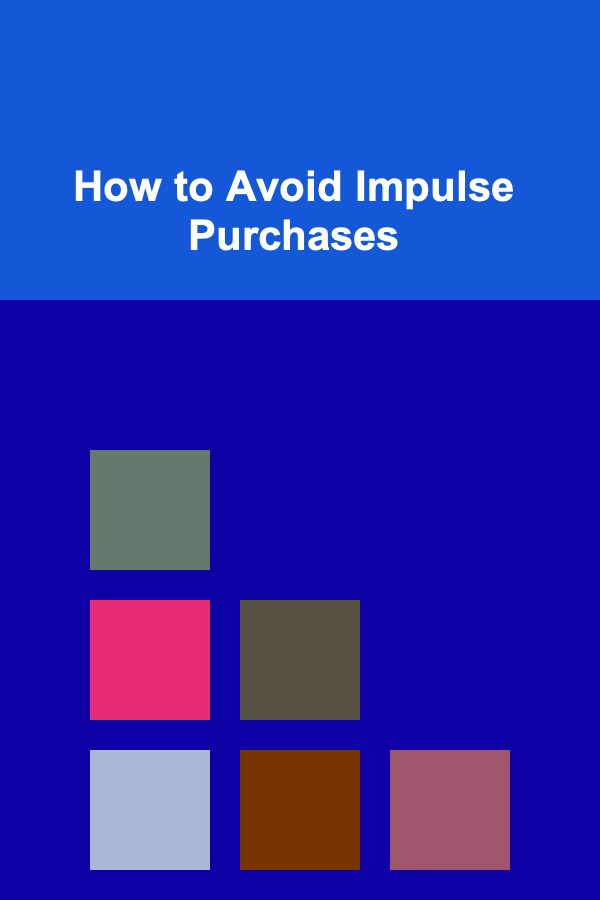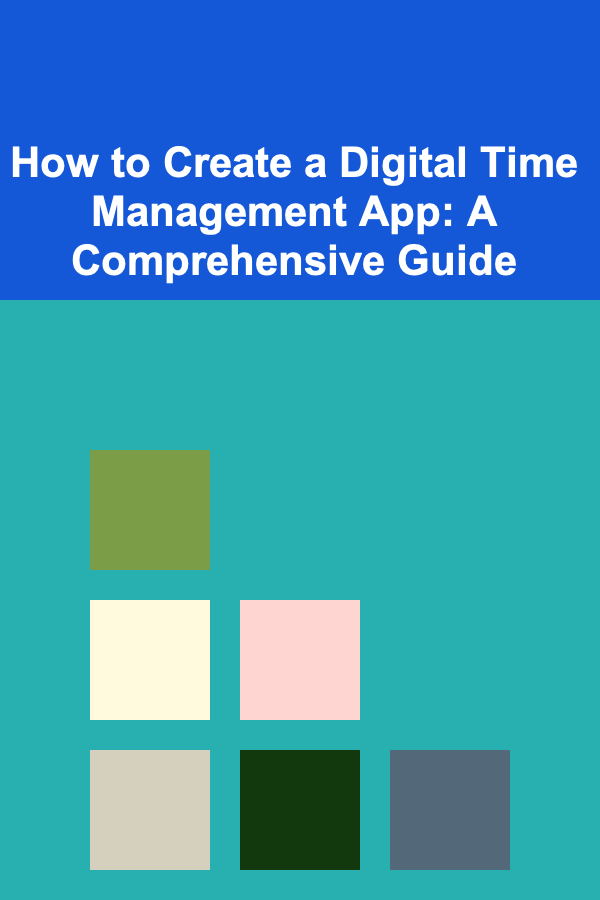
How to Avoid Impulse Purchases
ebook include PDF & Audio bundle (Micro Guide)
$12.99$9.99
Limited Time Offer! Order within the next:

Impulse purchases are a common issue for many people. The instant gratification they bring is tempting, and often, the thrill of acquiring something new makes us feel good. However, impulse buying can lead to financial strain, clutter, and even guilt. Many individuals struggle to control these urges, but with a bit of awareness, planning, and strategy, it's possible to minimize the habit and cultivate more mindful, intentional spending.
In this article, we will explore the psychology behind impulse purchases, why they happen, and how you can take steps to avoid them. By understanding the triggers and strategies to manage them, you can avoid unnecessary purchases and build better financial habits.
Understanding Impulse Purchases
Impulse buying is defined as the spontaneous and often irrational decision to purchase something without prior planning or thoughtful consideration. These purchases are frequently made on a whim and typically involve items that are not part of your original shopping list or budget.
Impulse buying can be triggered by various factors, such as emotional states, marketing strategies, or even social pressure. It's important to understand why we buy on impulse, as this knowledge is crucial in overcoming the behavior.
1.1 Psychological Triggers
There are several psychological triggers that fuel impulse purchases:
- Emotional Shopping: Sometimes, people turn to shopping as a form of self-soothing. Shopping can serve as a distraction from stress, sadness, or anxiety, providing temporary relief. However, the pleasure is often short-lived, and the emotional cycle repeats.
- Instant Gratification: Many impulse purchases are made because they satisfy the desire for instant gratification. When we want something right now, our brain releases dopamine---the "feel-good" neurotransmitter. This chemical reward can make us feel momentarily happy and fulfilled, but it fades quickly.
- Escapism: Shopping can also be an escape from negative emotions or the mundane. A new purchase can momentarily create a sense of excitement or control over one's life, especially when the rest of the day feels overwhelming.
- Social Influence: Peer pressure or societal expectations often play a role in impulse buying. If friends or family members are buying something, there can be a sense of needing to keep up or fit in.
- Availability and Convenience: With the rise of online shopping and quick purchase options, the ease of making a purchase is a significant contributor to impulse buying. Items are often just one click away, making it hard to resist.
1.2 The Marketing Influence
Retailers and marketers are well aware of these psychological triggers and often design their strategies to exploit them. They create environments and experiences that push consumers toward making impulse buys. This includes:
- Limited-Time Offers: Flash sales and countdowns encourage urgency. The fear of missing out (FOMO) can push people to make purchases they might otherwise have considered unnecessary.
- Product Placement: Items are often strategically placed at the checkout counter or within easy reach, making them hard to ignore. These strategically placed goods are designed to trigger spontaneous decisions.
- Discounts and Promotions: The idea of saving money is another strong motivator for impulse buying. "Buy one, get one free" or "70% off" deals can convince a consumer to purchase items they didn't intend to buy because they feel they are getting a good deal.
Understanding how these strategies work can help you become more aware of the subtle forces encouraging impulse purchases.
The Consequences of Impulse Buying
While impulse purchases can be exciting at the moment, they often come with negative long-term consequences. These include:
2.1 Financial Strain
One of the most obvious consequences of impulse buying is the financial impact. When you regularly make unplanned purchases, it can quickly add up. These small, seemingly insignificant expenses can lead to significant financial strain over time, especially if you're not tracking your spending.
2.2 Guilt and Regret
After the initial thrill wears off, many people experience feelings of guilt and regret. It's common to realize that the purchase wasn't necessary or that it wasn't a good use of your money. This negative emotion can lead to a cycle of poor financial decisions and low self-esteem.
2.3 Clutter and Disorganization
Impulse buying can also lead to physical clutter. The more you purchase on a whim, the more items you accumulate. Over time, this can lead to a disorganized and chaotic environment, which can impact your mental well-being.
2.4 Erosion of Long-Term Goals
Constantly indulging in impulse purchases can derail long-term financial goals, such as saving for retirement, buying a home, or going on a vacation. When you focus on short-term wants instead of long-term needs, you lose sight of your financial priorities.
2.5 Emotional Drain
While the initial purchase may provide emotional relief, the aftermath---such as guilt, anxiety about finances, and dissatisfaction---can negatively affect your emotional health.
How to Avoid Impulse Purchases
The good news is that impulse purchases can be avoided with intentional effort and mindfulness. Below are several strategies to help you avoid buying on impulse.
3.1 Create a Budget and Stick to It
One of the most effective ways to prevent impulse buying is by setting a clear budget. A well-planned budget allocates specific amounts of money for different categories (e.g., groceries, entertainment, savings), helping you stay on track with your spending.
- Track Your Expenses: Use budgeting apps or spreadsheets to track your expenses. Seeing where your money goes each month can help you identify areas where you may be overspending.
- Set Limits for Non-Essential Spending: If you tend to overspend in particular categories (like shopping or dining out), set firm limits. For example, allocate only a certain amount each month for non-essential purchases and avoid exceeding that amount.
3.2 Make a Shopping List and Stick to It
Planning your purchases in advance is a great way to avoid unnecessary spending. Before you go shopping---whether online or in-person---make a list of what you need and commit to buying only those items. Stick to your list and resist the urge to browse items outside of it.
- Use Lists for Online Shopping: Create shopping lists on e-commerce sites and add items only when you're certain you need them. Try to avoid impulse browsing when shopping online.
3.3 Give Yourself Time to Think
When you feel the urge to make an impulse purchase, take a step back. Give yourself time to think before committing to the purchase. A 24-hour rule can be effective: If you're unsure whether to buy something, wait a day before making the decision. This delay allows you time to evaluate whether the item is truly necessary.
- Pause Before Checkout: In the case of online shopping, leave items in your cart for a while before finalizing the purchase. This gives you time to reconsider whether you need the item.
3.4 Practice Mindful Shopping
Mindful shopping involves being fully aware of your needs, your emotions, and the impact of your purchases. Before making a purchase, ask yourself:
- Do I truly need this item?
- Is this purchase aligned with my values and financial goals?
- Will I still want this item in a week or a month?
Mindful shopping helps you to make conscious decisions, rather than falling victim to instant gratification.
3.5 Avoid Triggers
Identifying and avoiding the triggers that lead to impulse buying is an important step in controlling the behavior. These triggers could include:
- Social Media: If browsing social media leads you to discover sales or products that tempt you, try reducing your time on these platforms or unfollowing accounts that promote excessive consumerism.
- Email Subscriptions: Unsubscribe from email lists that send you frequent promotional offers, as these can create a sense of urgency and encourage impulse buying.
- Stores or Websites: If you know that certain stores or websites make it difficult for you to resist impulse buys, avoid browsing them, or plan your visits with specific, non-impulse-driven objectives in mind.
3.6 Limit Credit Card Use
Credit cards can make purchases feel less immediate because they allow you to buy now and pay later. However, this ease of use can make it easier to make impulse purchases. Consider leaving your credit card at home when you go out or using debit cards or cash to limit your spending.
- Use Prepaid Cards: Another effective strategy is to use a prepaid card with a fixed amount of money. This allows you to enjoy the shopping experience while keeping your spending within limits.
3.7 Find Alternative Ways to Fulfill Emotional Needs
Instead of using shopping as a way to cope with stress or emotions, try to find other outlets. Activities like exercise, journaling, spending time with loved ones, or engaging in hobbies can provide emotional fulfillment without the financial cost.
- Meditation and Mindfulness: These practices can help you recognize and manage emotional triggers that lead to impulse buying, helping you make more mindful decisions.
3.8 Accountability and Support
If you struggle with impulse buying, consider enlisting the support of a friend or family member. Having someone to hold you accountable can make it easier to stick to your goals and resist the temptation to make unnecessary purchases.
- Join a Community: Consider joining a budgeting or saving group. Sharing experiences and challenges with others who have similar financial goals can provide encouragement and motivation to avoid impulse buying.
Conclusion
Impulse purchases may feel gratifying in the moment, but they can lead to long-term financial and emotional consequences. By understanding the psychology behind impulse buying and implementing strategies to control it, you can build healthier spending habits and avoid unnecessary purchases.
Start by creating a budget, making a shopping list, and practicing mindfulness when shopping. Take the time to evaluate your emotional triggers and develop healthier coping mechanisms. With awareness and self-control, it's possible to minimize impulse buying and create a more intentional and fulfilling financial life.
By avoiding impulse purchases, you can move closer to your long-term financial goals, reduce stress, and build a healthier, more satisfying relationship with your finances.

How to Brighten a Small Space with Strategic Lighting
Read More
How to Build a Content Promotion Checklist for Content Partnerships
Read More
How to Create a Digital Time Management App: A Comprehensive Guide
Read More
How to Make Money Online as a Pharmacist: 10 Actionable Ideas
Read More
How to Remove Pet Stains from Furniture and Upholstery
Read More
How to Use Wall-Mounted Racks for Efficient Garage Storage
Read MoreOther Products

How to Brighten a Small Space with Strategic Lighting
Read More
How to Build a Content Promotion Checklist for Content Partnerships
Read More
How to Create a Digital Time Management App: A Comprehensive Guide
Read More
How to Make Money Online as a Pharmacist: 10 Actionable Ideas
Read More
How to Remove Pet Stains from Furniture and Upholstery
Read More